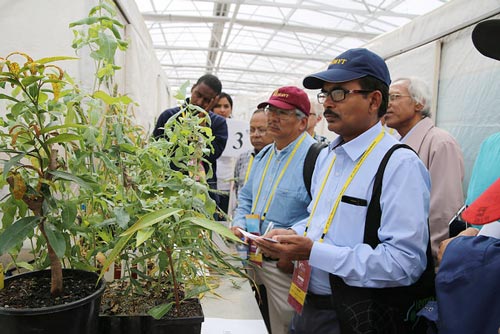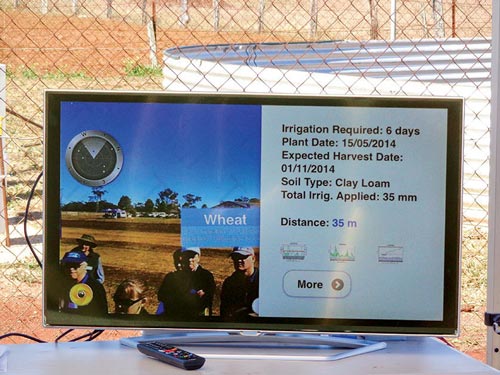 SYDNEY, Australia, October 9 (CIMMYT) – A recent gathering of more than 600 international scientists highlighted the complexity of wheat as a crop and emphasized the key role wheat research plays in ensuring global food security now and in the future.
SYDNEY, Australia, October 9 (CIMMYT) – A recent gathering of more than 600 international scientists highlighted the complexity of wheat as a crop and emphasized the key role wheat research plays in ensuring global food security now and in the future.
Specialist scientists and other members of the global wheat community attended two back-to-back wheat symposiums stretching over nine days from September 17 to 25 in Sydney, Australia. The first, a workshop hosted by the Borlaug Global Rust Initiative (BGRI), focused on Ug99 wheat rust disease. At the second, the five-day International Wheat Conference, which is held every five years, scientists dissected topics ranging from the intricate inner workings of the wheat genome to nutritional misrepresentations of wheat in the popular media.
Hans Braun, head of the Global Wheat Program at the International Maize and Wheat Improvement Center (CIMMYT) and the CGIAR Wheat Research Program, delivered a keynote presentation focused on new research, which shows that about 70 percent of spring bread and durum wheat varieties released in developing countries over the 20-year period between 1994 and 2014 were bred or are derived from wheat lines developed by scientists working for the CGIAR consortium of agricultural researchers. On a global basis, more than 60 percent of the released varieties are related to CIMMYT or International Center for Agricultural Research in the Dry Areas (ICARDA) germplasm.
Benefits of CGIAR wheat improvement research, conducted mainly by CIMMYT and ICARDA, range from $2.8 billion to $3.8 billion a year, he said, highlighting the economic benefits of international collaboration in wheat improvement research.
“Investment in agricultural research pays a huge dividend,” said Martin Kropff, CIMMYT’s director general, during a keynote address. “Investment in public research is a ‘triple win,’ leading to more food and income for the rural poor, lower prices for the urban poor, and extra stability and income for farmers in developed donor countries such as Australia, where gains are tens of millions a year.”
Bram Govaerts, who heads sustainable intensification efforts for CIMMYT in Latin America and leads the MasAgro project, demonstrated how minimal soil disturbance, permanent soil cover, and crop rotation can simultaneously boost yields, increase profits and protect the environment. Under MasAgro, some 400,000 hectares have been planted using improved technologies and agronomic practices; more than 200,000 producers are involved, of which 21 percent are women.
Sanjaya Rajaram, former CIMMYT wheat program director and 2014 World Food Prize laureate, described how wheat production must increase from the current 700 million metric tons a year to 1 billion metric tons a year by 2050 in order to keep up with population growth. Wheat currently provides 20 percent of calories and 20 percent of protein in the global human diet, he said, adding that the world’s food supply also faces the threat of climate-change related global warming.
“To date, scientists have been unable to sufficiently increase yields to meet demand through hybridization,” Rajaram said. “It’s time to invest in biotechnology to ensure yields can provide nourishment for an ever-hungrier planet. Simultaneously, we must maintain balance in the food chain and restore depleted carbon in the soil. Such concerns as disease resilience, seed diversity, water management and micronutrient imbalance must also be tackled.”
Ethiopia-based CIMMYT scientist David Hodson provided a retrospective on 10 years of Ug99 stem rust surveillance, while Kenya-based CIMMYT scientist Sridhar Bhavani provided an overview of progress made in breeding durable adult plant resistance to rust diseases and combining rust resistance in high yielding backgrounds over the past decade.
The Ug99 virulent disease threatens food security as it creeps steadily from its origin in Uganda towards the breadbasket regions of Asia.
“Technology can help us fight Ug99 stem rust, but we’re always going to need good field pathologists and researchers on the ground,” said Hodson, who also runs the Rust Tracker website.
Despite efforts to develop wheat that is resistant to damaging stem, stripe, and leaf rusts, these diseases, which have existed for 10,000 years, will continue to thwart scientists, said Philip Pardey, a professor in the Department of Applied Economics at the University of Minnesota, adding that the annual global investment in wheat rust research should be $108 million a year in perpetuity.
Pardey determined in a recent study that global losses from all three rusts average at least 15.04 tons a year, equivalent to an average annual loss of about $2.9 billion.
Jessica Rutkoski, a quantitative geneticist who works as an adjunct associate scientist at CIMMYT and an assistant professor at Cornell University, discussed the implications of new technologies for more durable resistance to rust.
Wheat physiology was also under discussion, with CIMMYT physiologists Matthew Reynolds and Gemma Molero delivering presentations on phenotyping, pre-breeding strategies, genetic gains, and spike photosynthesis. Their work also involves the use of ancient landraces, which may hold the secret to creating wheat resilient to global warming caused by climate change.
CIMMYT’s Alexey Morgunov demonstrated how a number of ancient landrace genotypes grown by farmers in Turkey have shown signs that they are resistant to abiotic and biotic stresses, which could help in the development of heat and disease resistant wheat varieties.
CIMMYT’s Zhonghu He discussed progress on wheat production and genetic improvement in China, while Sukhwinder Singh described his work characterizing gene bank biodiversity and mobilizing useful genetic variation – pre-breeding – into elite breeding lines. Bhoja Basnet covered hybrid wheat breeding at CIMMYT.
A session on nutrition and wheat targeted some of the myths swirling around wheat and gluten. CIMMYT’s Velu Govindan gave an update on his research into breeding and delivering biofortified high zinc wheat varieties to farmers. Zinc deficiency limits childhood growth and decreases resistance to infections.
Kropff also delivered a keynote presentation on wheat and the role of gender in the developing world, which preceded the BGRI Women in Triticum Awards, presented by Jeanie Borlaug Laube, daughter of the late Nobel Peace Prize laureate and CIMMYT wheat breeder Norman Borlaug.
Kropff explained that each component of the strategy for research into wheat farming systems at CIMMYT includes a gender dimension, whether it is focused on improving the evidence base, responding to the fact that both women and men can be end users and beneficiaries of new seeds and other technologies, or ensuring that gender is considered part of capacity-building efforts.
Bekele Abeyo, CIMMYT wheat breeder and pathologist for sub-Saharan Africa, won a $100 prize in the BGRI poster competition for his poster explaining the performance of CIMMYT-derived wheat varieties in Ethiopia.
A team of Kenyan scientists were recognized for their contribution to the protection of the global wheat supply from Ug99 stem rust disease. Plant pathologist Ruth Wanyera and wheat breeders Godwin Macharia and Peter Njau of the Kenya Agriculture and Livestock Research Organization received the 2015 BGRI Gene Stewardship Award.

 Capacity development
Capacity development